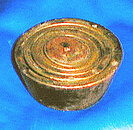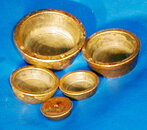TheMuseumGuy
Guest
- Messages
- 27
- Reaction score
- 0
- # of dives
- I'm a Fish!
Hey fellow adventurers, we found a complete set of nesting scale weights from 1765 and I took each and the whole and put them on a very modern digital scale and I can't believe how accurate they are!
I am attaching pictures, I hope, that shows them, but the main thing here is the breakdown of each individual piece keeping in mind there is still a bit of encrustation on some areas with degridation on other areas on each piece, hence the weight variation I believe, or we would be even more amazed!
We found them piece by piece and it took finding two pieces to realize what we had. 98% of the nesting scale weights recovered are missing the smallest one we have heard, go figure, but actually that is the first piece we found since we grid so well in our endeavors.
WEIGHTS:
Smallest to biggest:
1.81
1.82
3.59
7.27
13.64
Total
28.13
I'm flabbergasted! Man I love this stuff!
I hope to be broadcasting live from the excavation soon from our site OldShip.org...keep in touch!
Jack
I am attaching pictures, I hope, that shows them, but the main thing here is the breakdown of each individual piece keeping in mind there is still a bit of encrustation on some areas with degridation on other areas on each piece, hence the weight variation I believe, or we would be even more amazed!
We found them piece by piece and it took finding two pieces to realize what we had. 98% of the nesting scale weights recovered are missing the smallest one we have heard, go figure, but actually that is the first piece we found since we grid so well in our endeavors.
WEIGHTS:
Smallest to biggest:
1.81
1.82
3.59
7.27
13.64
Total
28.13
I'm flabbergasted! Man I love this stuff!
I hope to be broadcasting live from the excavation soon from our site OldShip.org...keep in touch!
Jack








